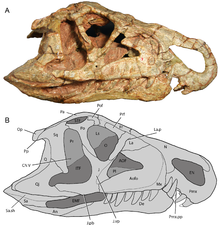| Riojasuchus Temporal range: Norian ~ | |
|---|---|
 | |
| Holotype skull and diagram | |
| Scientific classification | |
| Domain: | Eukaryota |
| Kingdom: | Animalia |
| Phylum: | Chordata |
| Class: | Reptilia |
| Clade: | Archosauria |
| Clade: | Pseudosuchia |
| Family: | † Ornithosuchidae |
| Genus: | † Riojasuchus Bonaparte 1969 |
| Type species | |
| Riojasuchus tenuisceps Bonaparte 1969 | |
Riojasuchus is an extinct genus of ornithosuchid archosaur from the Late Triassic (Norian) of Argentina. Ornithosuchidae was a widespread family of facultatively bipedal pseudosuchians (crocodilian-line archosaurs) with adaptations for scavenging. [1] [2] Riojasuchus is notable as one of the youngest and most complete members of the family. The type and only known species, Riojasuchus tenuisceps, was named and described by José Bonaparte in 1967. [3] It was one of the first of many well-preserved Triassic archosaurs to be discovered in Argentina. The holotype specimen, PVL 3827, was found in the Los Colorados Formation of the Ischigualasto-Villa Unión Basin in northwestern Argentina. [4] [5]





